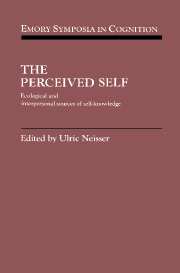Book contents
- Frontmatter
- Contents
- Preface
- List of contributors
- Part I Introduction
- Part II The concept of an ecological self
- 2 Ontogenesis of the perceived self
- 3 Body–environment coupling
- 4 A theory of representation-driven actions
- 5 The ecological self in historical context
- 6 Good intentions and dancing moments: Agency, freedom, and self-knowledge in dance
- 7 The primacy of the ecological self
- Part III The interpersonal self and its implications
- Author index
- Subject index
5 - The ecological self in historical context
Published online by Cambridge University Press: 29 March 2010
- Frontmatter
- Contents
- Preface
- List of contributors
- Part I Introduction
- Part II The concept of an ecological self
- 2 Ontogenesis of the perceived self
- 3 Body–environment coupling
- 4 A theory of representation-driven actions
- 5 The ecological self in historical context
- 6 Good intentions and dancing moments: Agency, freedom, and self-knowledge in dance
- 7 The primacy of the ecological self
- Part III The interpersonal self and its implications
- Author index
- Subject index
Summary
This chapter relates the concept of the ecological self, as described in Ulric Neisser's “Five Kinds of Self-Knowledge” (1988), to research and theory on the perceptual and cognitive aspects of body experience, particularly as these concern self-awareness. By and large, the relationship is established by adopting a historical perspective, describing a context and line of continuity that integrate that corpus of research and theory with many of the topics discussed in this volume.
Two ecological psychologies
J J. Gibson
According to Neisser, “The ecological self is the self as perceived with respect to the physical environment: “I” am the person here in this place, engaged in this particular activity” (1988, p. 36). The concept of ecological selfhood has its origins in the theory promulgated by J. J. Gibson, that systematic flow patterns in the visual field contain sufficient information to specify the situations that give rise to them. These ideas were first proposed to explain visual perception (Gibson, 1950). They evolved into a more general ecological psychology that assigns objective existence to information that arises from the external world (Gibson, 1979; Neisser, 1990).
- Type
- Chapter
- Information
- The Perceived SelfEcological and Interpersonal Sources of Self Knowledge, pp. 89 - 101Publisher: Cambridge University PressPrint publication year: 1994



